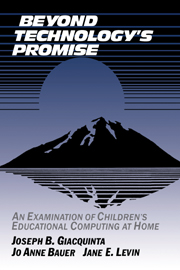Book contents
- Frontmatter
- Contents
- List of Tables and Figures
- Preface
- Chapter 1 THE PROMISE
- Chapter 2 STUDYING THE PROMISE
- Chapter 3 THE ABSENCE OF CHILDREN'S ACADEMIC COMPUTING AT HOME
- Chapter 4 THE AVAILABILITY OF EDUCATIONAL SOFTWARE
- Chapter 5 THE IMPORTANCE OF PARENTAL ENCOURAGEMENT AND ASSISTANCE
- Chapter 6 THE ROLE OF GENDER IN HOME COMPUTER USE
- Chapter 7 SCHOOL USE OF COMPUTERS
- Chapter 8 CHILDREN'S PREFERENCE FOR GAMES
- Chapter 9 REDEFINING A NEW TECHNOLOGY AS A SOCIAL INNOVATION
- Chapter 10 VIEWING TECHNOLOGICAL CHANGE AS A SOCIAL PROCESS
- Chapter 11 REEXAMINING THE HOME-SCHOOL COMPUTER CONNECTION
- Chapter 12 WHERE DO WE GO FROM HERE?
- Appendix A A FURTHER NOTE ON SITE FIELDWORK AND ANALYSIS
- Appendix B LIST OF CODES FOR SITE LOG ANALYSIS
- Appendix C SITE LOG ANALYSIS CODEBOOK
- Appendix D LIST OF FAMILIES AND SCHOOL-AGED CHILDREN
- Appendix E SPECIFIC STEPS FAMILIES MIGHT TAKE
- References
- Index
Chapter 10 - VIEWING TECHNOLOGICAL CHANGE AS A SOCIAL PROCESS
Published online by Cambridge University Press: 05 March 2012
- Frontmatter
- Contents
- List of Tables and Figures
- Preface
- Chapter 1 THE PROMISE
- Chapter 2 STUDYING THE PROMISE
- Chapter 3 THE ABSENCE OF CHILDREN'S ACADEMIC COMPUTING AT HOME
- Chapter 4 THE AVAILABILITY OF EDUCATIONAL SOFTWARE
- Chapter 5 THE IMPORTANCE OF PARENTAL ENCOURAGEMENT AND ASSISTANCE
- Chapter 6 THE ROLE OF GENDER IN HOME COMPUTER USE
- Chapter 7 SCHOOL USE OF COMPUTERS
- Chapter 8 CHILDREN'S PREFERENCE FOR GAMES
- Chapter 9 REDEFINING A NEW TECHNOLOGY AS A SOCIAL INNOVATION
- Chapter 10 VIEWING TECHNOLOGICAL CHANGE AS A SOCIAL PROCESS
- Chapter 11 REEXAMINING THE HOME-SCHOOL COMPUTER CONNECTION
- Chapter 12 WHERE DO WE GO FROM HERE?
- Appendix A A FURTHER NOTE ON SITE FIELDWORK AND ANALYSIS
- Appendix B LIST OF CODES FOR SITE LOG ANALYSIS
- Appendix C SITE LOG ANALYSIS CODEBOOK
- Appendix D LIST OF FAMILIES AND SCHOOL-AGED CHILDREN
- Appendix E SPECIFIC STEPS FAMILIES MIGHT TAKE
- References
- Index
Summary
Change is a process, not an event … a lesson learned the hard way by those who put all their energies into developing an innovation … without thinking through what would have to happen beyond that point.
(Fullan, 1991, p. 49)We argued earlier that the effective use of a technology requires a clear vision of an appropriate social envelope, a point that policy makers and advocates of home computers for education tend to miss. However, clear visions of home computing are not enough. In this chapter, we argue that such visions have to be enacted in homes. They do not occur automatically, as the technologically minded so often seem to assume, by simply “letting the technology loose.”
A second broad lesson of our research is that creators and champions of home educational computing need to view the effective use of a technology as the consequence of a multistaged, social process of diffusion, adoption, and then implementation. The evidence uncovered by our study suggests that most “strategies” used by marketers or advocates to get educational software and hardware into homes are seriously flawed. Their strategies often limit diffusion, curtail adoption, or overlook the problematic nature of implementation. The prevailing “here it is, buy it” and then “simply do it” approach may work for the occasional or passionately proactive family. It is not sufficient for most others.
In this chapter, we review our findings in light of the aforementioned steps in the planned change process.
- Type
- Chapter
- Information
- Beyond Technology's PromiseAn Examination of Children's Educational Computing at Home, pp. 149 - 166Publisher: Cambridge University PressPrint publication year: 1994

